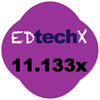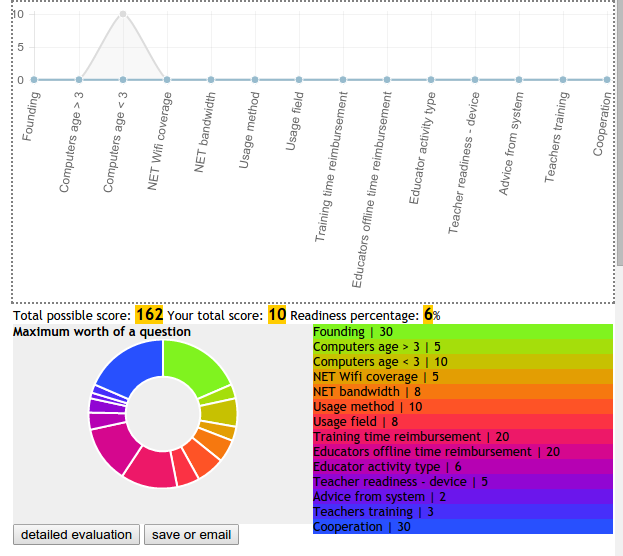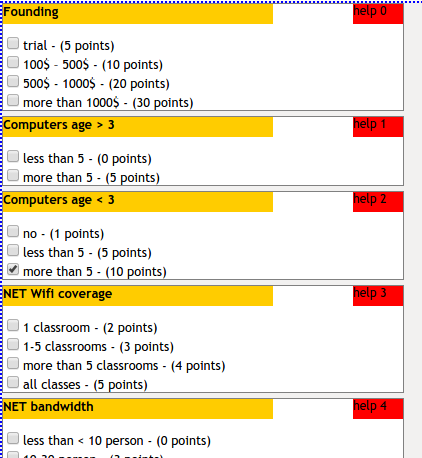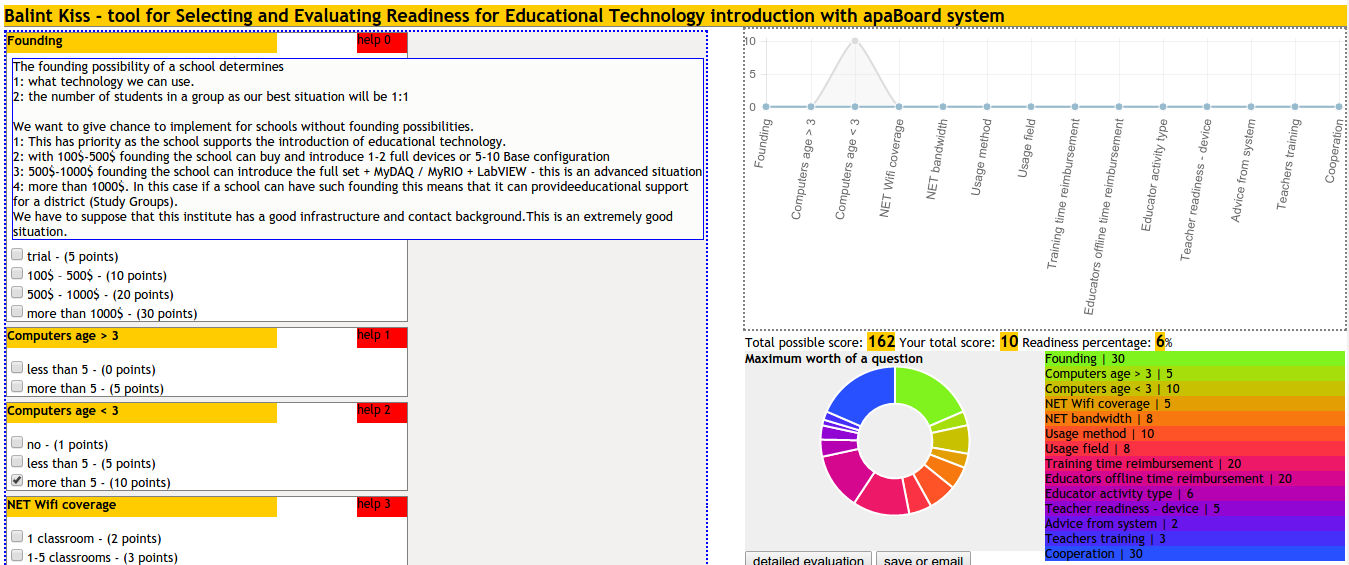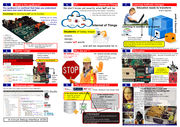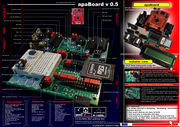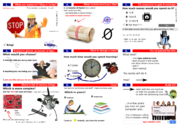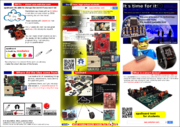„MITx 11.133x - work” változatai közötti eltérés
| (52 közbenső módosítás ugyanattól a szerkesztőtől nincs mutatva) | |||
| 9. sor: | 9. sor: | ||
|- | |- | ||
| | | | ||
[[Fájl:11 | [[Fájl:11 133 logo.png|100x100px|center|11 113 logo.png]] | ||
||[[Fájl:Eric klopfer.jpg|100x100px|center|Eric klopfer.jpg]] | ||[[Fájl:Eric klopfer.jpg|100x100px|center|Eric klopfer.jpg]] | ||
|} | |} | ||
| 20. sor: | 20. sor: | ||
==== ASSIGNMENT 0.2: TALK ABOUT EDUCATIONAL TECHNOLOGY IN THE CLASSROOM ==== | ==== ASSIGNMENT 0.2: TALK ABOUT EDUCATIONAL TECHNOLOGY IN THE CLASSROOM ==== | ||
===== Learning technology using educational technology ===== | |||
<html> | <html> | ||
<iframe width="560" height="315" src="https://www.youtube.com/embed/p8ZouxwEPYM?rel=0" frameborder="0" allowfullscreen></iframe> | <body> | ||
<table style="width:20%"> | |||
<head> | |||
<style> | |||
table, th, td { | |||
} | |||
.header { | |||
border-right: 5px solid #FFFFFF; | |||
background-color:#FF6205; | |||
color:white; | |||
margin:0px; | |||
padding:3px; | |||
font-size:12pt; | |||
font-weight:bold; | |||
border-bottom: 5px solid #FFFFFF; | |||
text-align: center; | |||
} | |||
.text { | |||
border-right: 5px solid #FFFFFF; | |||
background-color:#E6E6E6; | |||
color:#000000; | |||
font-size:10pt; | |||
padding:20pt; | |||
margin:0px; | |||
border-bottom: 5px solid #FFFFFF; | |||
vertical-align: top; | |||
text-align: left; | |||
} | |||
.icon { | |||
border-right: 5px solid #FFFFFF; | |||
background-color:#E6E6E6; | |||
color:#000000; | |||
font-size:10pt; | |||
padding:20pt; | |||
margin:0px; | |||
border-bottom: 5px solid #FFFFFF; | |||
vertical-align: center; | |||
text-align: center; | |||
} | |||
</style> | |||
</head> | |||
<body> | |||
<tr> | |||
<td class="header">Learning technology using educational technology</td> | |||
</tr> | |||
<tr> | |||
<td class="text"> | |||
Hello I'm Bálint Kiss 18 years old student from Hungary. Ed tech completely changed my life.<br> | |||
I'm interested in EECS learning, developing and instruction of electronic devices.<br><br> | |||
I wanted to learn how these devices are working: like <a href="https://www.arduino.cc/en/Main/Products" target="_blank">Arduinos</a>, <a href="http://www.ti.com/ww/en/launchpad/launchpad.html" target="_blank">TI Launchpads</a>. I've got a lot of free online resources but after some years of doing experiments I want to learn deeply the ARM microcontrollers. | |||
</td> | |||
</tr> | |||
<tr> | |||
<td class="text"><iframe width="560" height="315" src="https://www.youtube.com/embed/p8ZouxwEPYM?rel=0" frameborder="0" allowfullscreen></iframe> | |||
</td> | |||
</tr> | |||
<tr> | |||
<td class="text"> | |||
Here at edX I found the course named <strong><a href="https://www.edx.org/course/embedded-systems-shape-world-utaustinx-ut-6-02x" target="_blank">Shape the World</a> </strong>with professor Valvano and professor Yerraballi. That was exciting and <a href="https://verify.edx.org/cert/3dec12c4a53941fd889f2d8b82399e67" target="_blank">I've got my certificate</a>.<br><br> | |||
I've learned that the most important thing is: by using educational technology <strong>I know what I want to learn</strong>. By Using educational technology the <strong>learning process can be very easy and exciting</strong>.<br><br> | |||
With the knowledge from edx i've designed a new tool for learning electronics by succesfull experiments. This is <strong><a href="http://eskolar.com/about/en/" target="_blank">my tool called apaBoard</a></strong>.<br> | |||
It uses a modular system. You can connect modules to modules and build devices without deep previous knowledge. <br> | |||
Everybody can build, design and construct what he or she wants, and <strong>learn electronics by building devices</strong>.<br><br> | |||
My project became quite successfull. It won a lot of prizes, I've presented my device at national and international competitions and conferences like <a href="http://eucys2014.pl/" target="_blank">EUCYS in Poland</a> and<a href="http://www.esi2015.be/" target="_blank"> Milset 2015 in Brusseles</a>. <br><br> | |||
My mentor Kertesz Krisztian who works at Institute of <a href="http://www.mfa.kfki.hu/en" target="_blank">Technical Physics and Materials Science of the Hungarian Academy of Sciences</a> said that if I've taught myself let's try whether this method would work for other students.<br><br> | |||
So I put all my exciting experiments into this box. It is the deluxeBox. I went to schools and I've presented to more than 1000 students in classrooms and conferences. Students who have tried some of my experiments, said they would like to use my devices and methods.<br><br> | |||
Now I'm interested in learning ed methods and technologies to use Massive Open Online Course for those students who are interested in learning with my electronic devices and my tools. I've learned to use a lot of software for building multimedia content, step-by-step wikis, videos, graphs, animations. <br> | |||
I am building my own <a href="http://eskolar.com/about/en/" target="_blank">website</a>, <a href="http://eskolar.com/apa/index.php/Motor_Servo" target="_blank">wiki site with multimedia content</a> and I want to learn & use ed. tech. very efficiently. | |||
</td> | |||
</tr> | |||
</table> | |||
</body> | |||
</html> | </html> | ||
=== Unit 1: Foundations === | === Unit 1: Foundations === | ||
==== ASIGNMENT 1.1: PROFILE YOUR TARGET ENVIRONMENT/IMPLEMENTATION CONTEXT ==== | ==== ASIGNMENT 1.1: PROFILE YOUR TARGET ENVIRONMENT/IMPLEMENTATION CONTEXT ==== | ||
===== IoT learning IMPLEMENTATION CONTEXT ===== | |||
<html> | <html> | ||
<iframe width="560" height="315" src="https://www.youtube.com/embed/ | <body> | ||
<head> | |||
<style> | |||
table, th, td { | |||
} | |||
.header { | |||
border-right: 5px solid #FFFFFF; | |||
background-color:#FF6205; | |||
color:white; | |||
margin:0px; | |||
padding:3px; | |||
font-size:12pt; | |||
font-weight:bold; | |||
border-bottom: 5px solid #FFFFFF; | |||
text-align: center; | |||
} | |||
.text { | |||
border-right: 5px solid #FFFFFF; | |||
background-color:#E6E6E6; | |||
color:#000000; | |||
font-size:10pt; | |||
padding:20pt; | |||
margin:0px; | |||
border-bottom: 5px solid #FFFFFF; | |||
vertical-align: top; | |||
text-align: left; | |||
} | |||
.icon { | |||
border-right: 5px solid #FFFFFF; | |||
background-color:#E6E6E6; | |||
color:#000000; | |||
font-size:10pt; | |||
padding:20pt; | |||
margin:0px; | |||
border-bottom: 5px solid #FFFFFF; | |||
vertical-align: center; | |||
text-align: center; | |||
} | |||
</style> | |||
</head> | |||
<body> | |||
<table style="width:560px"> | |||
<tr> | |||
<td class="header"> IoT learning IMPLEMENTATION CONTEXT</td> | |||
</tr> | |||
<tr> | |||
<td class="text"><a href="http://apaboard.eskolar.com/" target="_blank">My tool and method</a> is for K12 (K9-to-K12) for students, educators, and communication staff of technology developers like <a href="https://www.arduino.cc/en/Main/Products" target="_blank">Arduino</a>, <a href="http://www.ti.com/ww/en/launchpad/launchpad.html" target="_blank">TI Launchpad</a>,<a href="http://www.ni.com/mydaq/" target="_blank"> NI MyDAQ</a>, <a href="http://www.ni.com/myrio/" target="_blank">MyRIO</a>. | |||
It can be implemented in <strong><a href="http://eskolar.com/apa/index.php/Bemutat%C3%B3" target="_blank">curriculum</a></strong> in learning process of electronics, informatics, physics.<br> | |||
We can get <strong>up-to-date experience</strong> for young students who are intreseted in learnig, understanding electronic technology even if they haven't pevious knowledge.</td> | |||
</tr> | |||
<tr> | |||
<td class="text"><iframe width="560" height="315" src="https://www.youtube.com/embed/bXQUKyoSYNA?rel=0" frameborder="0" allowfullscreen></iframe> | |||
</td> | |||
</tr> | |||
<tr> | |||
<td class="text">The technological background means that students and teachers are using a learning tool named <strong>embedded system</strong> and they have access to online materials like videos, wikis, step-by-step multimedia tutorials.<br> | |||
The total cost is between <strong>10$ </strong>and 300$ USD depending on the embedded system that someone has chosen.<br><br> | |||
I have worked with <a href="https://www.arduino.cc/en/Main/Products" target="_blank">Arduino</a>, <a href="http://www.ti.com/ww/en/launchpad/launchpad.html" target="_blank">TI Launchpad</a>,<a href="http://www.ni.com/mydaq/" target="_blank"> NI MyDAQ</a>, <a href="http://www.ni.com/myrio/" target="_blank">MyRIO</a>. <br><br> | |||
<strong>By online tutorials</strong> students may go ahead by their <strong>own pace</strong> even without educator support.<br> | |||
It is very suitable for <a href="https://youtu.be/JK-ayxL27IE?t=1m15s" target="_blank"><strong>blended learning</strong></a>. In this case students can do experiments in small or larger groups. | |||
The teachers role is <strong>facilitator</strong> in this case. Also they are involved in building and developing new methods by <strong>successful experiments</strong>. A successful experiment will be inserted into the resource.<br><br> | |||
<strong>Stakeholders:</strong><br> | |||
<strong>Students</strong> are able to learn in a short time high technology and can access and use hightech developments.<br> | |||
<strong>Teachers</strong> using these resources could be more efficient as they don't have to worry about developing experiments. Together with teachers, students connect the available modules what they need and they built a new device.<br> | |||
<strong>Industrial environment</strong> is a very intresting stakeholder.<br> | |||
Technology developers interested in usage and selling high-tech microcontrollers are also interested in education and communication of technology. Industry is also interested in <strong>dialogue</strong> with educators, mentors and teachers.<br> | |||
Technology developers say that those young people, who can build those new devices called <a href="http://www.ti.com/ww/en/internet_of_things/" target="_blank"><strong>IoT(Internet of Things)</strong></a>, will shape the world and they are interested in using their specific technologies or devices.<br> | |||
I must mention the very improtant role of the <strong>researce centers (<a href="http://www.mfa.kfki.hu/en" target="_blank">MFA</a>) & science centers (<a href="http://www.agoradebrecen.hu/en/" target="_blank">Agora</a>, <a href="http://www.mobilis-gyor.hu/" target="_blank">Mobilis</a>)</strong>.<br><br> | |||
Using technology can make a lesson more <strong>powerful</strong> to students.<br> | |||
Student can have hard time to make an experiment and build everything correctly.<br> | |||
This can be achieved by using <strong>my online resources:</strong><br><br> | |||
1. The <strong><a href="https://www.youtube.com/channel/UCbIsVvjxR8oiRQkctFVUuHQ" target="_blank">videos</a></strong> explain the problem.<br> | |||
2. <a href="http://eskolar.com/apa/index.php/Motor" target="_blank"><strong>Step-by-step multimedia</strong></a> contents let the students go ahead by their own pace to buil a correct device.<br> | |||
3. <strong><a href="http://eskolar.com/apa/" target="_blank">Wiki</a></strong> contents are summerise and contain all descriptions, documentations, source codes.<br> | |||
4. <strong>Feedback</strong> is in real time. If someone follows these tutorials will build a working device. It will work.<br><br> | |||
<strong>Why is potential for technology to be implemented in this context?</strong><br><br> | |||
My experience is that students became very <strong>motivated</strong> to learn by building successful devices. In this case the knowledge <strong>can be used in real life</strong>.<br> | |||
Building a toy or building a real device is exactly the same.<br> | |||
While <strong>constructing</strong>, building, developing some successful devicees we can have access to theoretical background <strong>as a next step</strong> for deep knowledge.</td> | |||
</tr> | |||
</table> | |||
</body> | |||
</html> | </html> | ||
==== ASSIGNMENT 1.2: DOMAIN/APPROACH CHART ==== | ==== ASSIGNMENT 1.2: DOMAIN/APPROACH CHART ==== | ||
===== LabVIEW helps to understand devices ===== | |||
<html> | |||
<body> | |||
<table style="width:560px"> | |||
<head> | |||
<style> | |||
table, th, td { | |||
} | |||
.header { | |||
border-right: 5px solid #FFFFFF; | |||
background-color:#FF6205; | |||
color:white; | |||
margin:0px; | |||
padding:3px; | |||
font-size:12pt; | |||
font-weight:bold; | |||
border-bottom: 5px solid #FFFFFF; | |||
text-align: center; | |||
} | |||
.text { | |||
border-right: 5px solid #FFFFFF; | |||
background-color:#E6E6E6; | |||
color:#000000; | |||
font-size:10pt; | |||
padding:20pt; | |||
margin:0px; | |||
border-bottom: 5px solid #FFFFFF; | |||
vertical-align: top; | |||
text-align: left; | |||
} | |||
.icon { | |||
border-right: 5px solid #FFFFFF; | |||
background-color:#E6E6E6; | |||
color:#000000; | |||
font-size:10pt; | |||
padding:20pt; | |||
margin:0px; | |||
border-bottom: 5px solid #FFFFFF; | |||
vertical-align: center; | |||
text-align: center; | |||
} | |||
</style> | |||
</head> | |||
<body> | |||
<tr> | |||
<td class="header">LabVIEW helps to understand devices</td> | |||
</tr> | |||
<tr> | |||
<td class="text"><strong>We use microcontrollers everyday and everywhere.</strong><br><br> | |||
In the learning process we can use the so called <strong>embedded systems</strong>. <br> | |||
There are quite cheap <strong>10$ solutions</strong> like <a href="http://www.ti.com/ww/en/launchpad/launchpad.html" target="_blank">TI Launchpads</a>, <a href="https://www.arduino.cc/en/Main/Products" target="_blank">Arduinos</a> and others with software and technical support like <a href="http://www.ni.com/mydaq/" target="_blank"> NI MyDAQ</a>, <a href="http://www.ni.com/myrio/" target="_blank">MyRIO</a> an <a href="http://www.ni.com/ni-elvis/" target="_blank">ELVIS</a>.<br><br> | |||
<strong>Free resources are often can be challenging</strong> for educators as they have to spend their time to learn how to visualise data. (<a href="http://energia.nu/" target="_blank">Energia IDE</a>, <a href="https://www.arduino.cc/en/main/software" target="_blank">Arduino IDE</a>, <a href="http://wiki.wiring.co/wiki/Main_Page" target="_blank">Wiring</a>, <a href="https://processing.org/" target="_blank">Processing</a>)<br></td> | |||
</tr> | |||
<tr> | |||
<td class="text"><iframe width="560" height="315" src="https://www.youtube.com/embed/dmIQn-LMVFg?rel=0" frameborder="0" allowfullscreen></iframe> | |||
</td> | |||
</tr> | |||
<tr> | |||
<td class="text"> | |||
<a href="http://www.ni.com/labview/" target="_blank">LabVIEW</a> can be a good choice. Educators, students can use<strong> drag & drop interactiv elements, buttons, graphs to simulate and visualise</strong> real time electronic events or data-flows.<br><br> | |||
In most of the IDEs (integrated development) could be very time consuming to develop such elements and suppose programing knowledge.<br> | |||
If we can't visualise data, students can <a href="http://energia.nu/reference/analogread/" target="_blank">see only numbers</a>.<br><br> | |||
The LabVIEW is developed by engineers and uses a graphical programming language.<br> | |||
LabVIEW's solutions witch are simple but at high-level can be <strong>succesfully</strong> used in learning process.<br> | |||
Educators, students can learn the basics of LabVIEW in a short time and a complete explanation of a concept can be visualised in a couple of minutes.<br><br> | |||
Students can <strong>quickly understand</strong>, what happens in a circuit or in a specific circumstance like using a specific sensor. <br> | |||
Also the usage of such a software is usefull beause this technology is used in <a href="http://us.ni.com/academic/software" target="_blank">high-educational</a>, <a href="http://www.ni.com/labview/applications/test/" target="_blank">industrial</a> or <a href="http://www.ni.com/labview/applications/daq/" target="_blank">research</a> environment too.<br><br> | |||
It is also a good argument that the developer (<a href="http://www.ni.com/" target="_blank">National Instruments</a>) offers suupport by it's <a href="http://www.ni.com/company/engineering-insights/stem/" target="_blank">Mentorship Program</a> (<a href="http://hungary.ni.com/debrecen/ni-mentor-program" target="_blank">Hungary</a>) to help and involve schools and educators.<br> | |||
</table> | |||
</body> | |||
</html> | |||
=== Unit 2: Selecting Educational Technology === | |||
==== ASSIGNMENT 2.1: YOUR TOOL FOR SELECTING EDUCATIONAL TECHNOLOGY ==== | |||
===== My interactive online tool to analyse readiness ===== | |||
<html> | |||
<body> | |||
<table style="width:560px"> | |||
<head> | |||
<style> | |||
table, th, td { | |||
} | |||
.header { | |||
border-right: 5px solid #FFFFFF; | |||
background-color:#FF6205; | |||
color:white; | |||
margin:0px; | |||
padding:3px; | |||
font-size:12pt; | |||
font-weight:bold; | |||
border-bottom: 5px solid #FFFFFF; | |||
text-align: center; | |||
} | |||
.text { | |||
border-right: 5px solid #FFFFFF; | |||
background-color:#E6E6E6; | |||
color:#000000; | |||
font-size:10pt; | |||
padding:20pt; | |||
margin:0px; | |||
border-bottom: 5px solid #FFFFFF; | |||
vertical-align: top; | |||
text-align: left; | |||
} | |||
.icon { | |||
border-right: 5px solid #FFFFFF; | |||
background-color:#E6E6E6; | |||
color:#000000; | |||
font-size:10pt; | |||
padding:20pt; | |||
margin:0px; | |||
border-bottom: 5px solid #FFFFFF; | |||
vertical-align: center; | |||
text-align: center; | |||
} | |||
</style> | |||
</head> | |||
<body> | |||
<tr> | |||
<td class="header">My interactive online tool to analyse readiness</td> | |||
</tr> | |||
<tr> | |||
<td class="text">I have got a great inspiration from Stacey Allen’s Rubric to Determine Readiness for 1:1 Implementation. Thank You Stacey Allen.<br />I’ve gathered my viewpoints and questions but my problem was that <strong>I dind’t feel the weight of a question</strong> in the evaluation process. | |||
</td> | |||
</tr> | |||
<tr> | |||
<td class="text"><iframe width="560" height="315" src="https://www.youtube.com/embed/MjXRT_YZCZ4?rel=0" frameborder="0" allowfullscreen></iframe> | |||
</td> | |||
</table> | |||
</body> | |||
</html> | |||
<html> | |||
<body> | |||
<head> | |||
<style> | |||
table, th, td { | |||
} | |||
.header { | |||
border-right: 5px solid #FFFFFF; | |||
background-color:#FF6205; | |||
color:white; | |||
margin:0px; | |||
padding:3px; | |||
font-size:12pt; | |||
font-weight:bold; | |||
border-bottom: 5px solid #FFFFFF; | |||
text-align: center; | |||
} | |||
.text { | |||
border-right: 5px solid #FFFFFF; | |||
background-color:#E6E6E6; | |||
color:#000000; | |||
font-size:10pt; | |||
padding:20pt; | |||
margin:0px; | |||
border-bottom: 5px solid #FFFFFF; | |||
vertical-align: top; | |||
text-align: left; | |||
} | |||
.icon { | |||
border-right: 5px solid #FFFFFF; | |||
background-color:#E6E6E6; | |||
color:#000000; | |||
font-size:10pt; | |||
padding:20pt; | |||
margin:0px; | |||
border-bottom: 5px solid #FFFFFF; | |||
vertical-align: center; | |||
text-align: center; | |||
} | |||
</style> | |||
</head> | |||
<body> | |||
<table style="width:560px"> | |||
<tr> | |||
<td class="header"> Tool for Selecting and Evaluating Readiness for Educational Technology introduction with apaBoard system </td> | |||
</tr> | |||
<tr> | |||
<td class="text"> <iframe width="1050px" height="700" src="http://eskolar.com/download/11_133/form/index.html" seamless></iframe> | |||
</td> | |||
</tr> | |||
</table> | |||
</body> | |||
</html> | |||
<html> | |||
<body> | |||
<table style="width:560px"> | |||
<head> | |||
<style> | |||
table, th, td { | |||
} | |||
.text { | |||
border-right: 5px solid #FFFFFF; | |||
background-color:#E6E6E6; | |||
color:#000000; | |||
font-size:10pt; | |||
padding:20pt; | |||
margin:0px; | |||
border-bottom: 5px solid #FFFFFF; | |||
vertical-align: top; | |||
text-align: left; | |||
} | |||
</style> | |||
</head> | |||
<body> | |||
<tr> | |||
<td class="text"><p> </p> | |||
<p><a title="http://eskolar.com/download/11_133/form/" href="http://eskolar.com/download/11_133/form/" target="_blank" rel="nofollow">Welcome to try it online from my webpage: </a><a href="http://eskolar.com/download/11_133/form/" rel="nofollow">http://eskolar.com/download/11_133/form/</a></p> | |||
<p>You know I had talked with more then one hundred teachers, more than one thousand students, I know what they want, and what I want.<br />I know the problems, but how much weights a problem in the solution? This is what I<br />can’t see.<br />So I tried with <a title="spreadsheet" href="https://ie.edtechx.org/blog/forums/topic/my-interactive-online-tool-to-analyse-readiness/ASSIGNMENT_2_1_spreadsheet.ods" target="_blank" rel="nofollow">a LibreOffice spreadsheet</a> to make some charts to see the <strong>relative weight of a problem</strong> in the readiness of introduction of my apaBoard.<br />And this was a pitch. I have added some values to the answers and these values can show the problems weight.</p> | |||
<p>In the next step I want that a school leader can use my selector tool to see whether the school is ready for implementation.<br />I asked help to apply this concept in a <strong>javascript</strong> programmed online <strong>HTML5 tool</strong>.</p> | |||
<p><a title="http://eskolar.com/download/11_133/form/" href="http://eskolar.com/download/11_133/form/" target="_blank" rel="nofollow">You can try it online from my webpage</a></p> | |||
<p><img src="http://eskolar.com/download/11_133/mytool_1.png" alt="mytool" width="560" height="500" /></p> | |||
<p><a title="myTool for apaBoard" href="http://eskolar.com/download/11_133/form/" target="_blank" rel="nofollow"><strong>I’m very-very exited it shows exactly what I want. </strong></a><br />It is easy to use and it is scalable, also open source to use by anybody for any purpose.<br />It has a data array, and if I have to modify I can do it in a moment.</p> | |||
<p><a title="download" href="http://eskolar.com/download/11_133/tool_for_edtech.zip" target="_blank" rel="nofollow">You can download it from this link.</a></p> | |||
<p>We have two charts. In this pie chart we can see the weight of a problem by its value number.<br />It is clear enough: <strong>Founding</strong> + <strong>Cooperation</strong> + <strong>Educators time reimbursement </strong>are the most important factors.<br />These definitely determines if the school is ready for implementation.<br />Also I have some interesting points like: <strong>Computers age</strong>, <strong>Net bandwidth</strong>, <strong>Usage method</strong>, <strong>Educator activity type</strong>.</p> | |||
<p>The line chart shows the value of the answer given by the school leader or the teacher.</p> | |||
<p><img src="http://eskolar.com/download/11_133/mytool_2.png" alt="mytool" width="558" height="605" /></p> | |||
<p>I have to finish the <strong>detailed evaluation answer</strong> option and I planned to <strong>get an email from the website</strong> with the values and to use these data in a database.</p> | |||
<p>Hope You will enjoy it.<br /><a href="http://eskolar.com/download/11_133/mytool_3.png"><img src="http://eskolar.com/download/11_133/mytool_3.png" alt="mytool" width="560" height="235" /></a></p></td> | |||
</table> | |||
</body> | |||
</html> | |||
==== ASSIGNMENT 2.2: CHOOSE THE RIGHT TECHNOLOGY ==== | |||
===== Choosing the right technology for apaBoard ===== | |||
<html> | |||
<body> | |||
<table style="width:560px"> | |||
<head> | |||
<style> | |||
table, th, td { | |||
} | |||
.header { | |||
border-right: 5px solid #FFFFFF; | |||
background-color:#FF6205; | |||
color:white; | |||
margin:0px; | |||
padding:3px; | |||
font-size:12pt; | |||
font-weight:bold; | |||
border-bottom: 5px solid #FFFFFF; | |||
text-align: center; | |||
} | |||
.text { | |||
border-right: 5px solid #FFFFFF; | |||
background-color:#E6E6E6; | |||
color:#000000; | |||
font-size:10pt; | |||
padding:20pt; | |||
margin:0px; | |||
border-bottom: 5px solid #FFFFFF; | |||
vertical-align: top; | |||
text-align: left; | |||
} | |||
.icon { | |||
border-right: 5px solid #FFFFFF; | |||
background-color:#E6E6E6; | |||
color:#000000; | |||
font-size:10pt; | |||
padding:20pt; | |||
margin:0px; | |||
border-bottom: 5px solid #FFFFFF; | |||
vertical-align: center; | |||
text-align: center; | |||
} | |||
</style> | |||
</head> | |||
<body> | |||
<tr> | |||
<td class="header">Choosing the right technology for apaBoard</td> | |||
</tr> | |||
<tr> | |||
<td class="text"> | |||
I am intrested in learning and teaching EECS (Electrical Engineering & Computer Sciences).<br> | |||
I would like to present it's problems, and my educational technology tools.<br> | |||
Also I will present my tools and my methods, for developeing electornic tools, and online tutorials with wikis, videos and multimedias.<br> | |||
<strong>Why is the technology you chose the best fit for your context/target environment? </strong> | |||
</td> | |||
</tr> | |||
<tr> | |||
<td class="text"> | |||
<iframe width="560" height="315" src="https://www.youtube.com/embed/wP1-prifnfM?rel=0" frameborder="0" allowfullscreen></iframe> | |||
</td> | |||
</tr> | |||
<tr> | |||
<td class="text"> | |||
<br> | |||
If we are teachers, we want to find answers about the following questions:<br> | |||
1. How can we easily build successful devices?<br> | |||
2. What is a simple programming language for students?<br> | |||
3. Do we have free (open source) online resources?<br> | |||
4. What are their cost? <br> | |||
<br> | |||
<strong>Electrical learning devices are determined by two main components, hardware & software.</strong><br> | |||
<br> | |||
Let see the hardware:<br> | |||
We can buy quite cheap solutions like <a href="http://www.ti.com/ww/en/launchpad/launchpad.html?DCMP=rtos&HQS=ep-sdo-rtos-pr-lp-launchpad-en" target="_blank">TI Launchpads</a>, <a href="https://www.arduino.cc/" target="_blank">Arduinos</a>. <br> | |||
These are simple <a href="https://en.wikipedia.org/wiki/Embedded_system" target="_blank">embedded sytems</a>, the embeded system contains only 1 MCU, and that is all.<br> | |||
But we <strong>want to build devices</strong> with sound, lights, leds, display, like <strong>robots</strong>, <strong>music toys</strong> or measuring centers...<br> | |||
We must <strong>connect sensors</strong> and <strong>drivers</strong> to the embedded sytems, and we are in trouble because such an <strong>experiment contains many parts</strong>.<br> | |||
It is a hard way for students, because <strong>building electronic devices can be very difficult, without previous knowlege.</strong><br> | |||
<br> | |||
If we want to buy kits, we have 2 ways:<br> | |||
1. To buy a component kit with resistors, capacitors, leds, motors, motor driver, sensors on PCB.<br> | |||
Also this way can be challenging for educators, as they have to spend their time building experiments.<br> | |||
2. Or you can choose a compact kit like <a href="http://www.ti.com/ww/en/launchpad/boosterpacks.html" target="_blank">boosterpacks</a> for launchpads or shields for arduinos. We can call these moduls.<br> | |||
In this case you can't connect all moduls to one device, because these standards have limitations.<br> | |||
<br> | |||
3. apaBoard is a tool which I've developed. It is a modular multitool. <br> | |||
<br> | |||
<a href="http://eskolar.com/about/en/" title="apaboard link" target="_blank"><strong>On my site You can get all information about the apaboard.</strong></a> | |||
<br> | |||
<img src="http://eskolar.com/apa/images/b/be/Apaboard_en_modules_szorolap.png" alt="apaboard" width="400px" /><br> | |||
<br> | |||
4. Another<strong> big challenge is</strong> that after the first steps, everybody would like <strong>to build, construct a physical device like robot with motors and arms</strong>. <br> | |||
<br> | |||
<strong>How can a teacher build a multipurpose, scalable device?</strong>. <br> | |||
I've got the solution, this is the Deluxe box but it is heavy and a big and more complex to be reproduced. <br> | |||
<img src="http://eskolar.com/apa/images/thumb/c/cf/DSC01983.JPG/800px-DSC01983.JPG" alt="deluxe" width="300px" /><br> | |||
This gives me the idea to make some little <strong>deluxe boxes</strong> which I named <strong>MyBox</strong>. It can be made from a single sheet of plexiglass with laser. And it is an <strong>universal case</strong> for all type of experiments. <br> | |||
Now we have a completely <strong>correct electrical experiment and we can build the multi purpose physical device</strong> too.<br> | |||
<img src="http://eskolar.com/apa/images/thumb/2/24/DSC01785_mybox.JPG/800px-DSC01785_mybox.JPG" alt="myBox" width="300px" /><br> | |||
<br> | |||
<strong>Softwares for programing MCUs:</strong><br> | |||
<br> | |||
1. The most of the <a href="http://www.ti.com/tool/ccstudio#descriptionArea" title="IDE" target="_blank">IDEs</a> use C, C++ language for programming registers. It is not a good solution for K12, is good for university's students or engineers.<br> | |||
2. But we have a lot of <strong>free IDEs</strong> for learning easly and working efficiently. Like Arduino IDE, and <a href="http://energia.nu/" target="_blank">Energia IDE</a>.<br> | |||
These are using a simplefied C language, based on wiring, and they are good solution for K12's students.<br> | |||
3. Now <strong>we can do devices and we can program their MCU'</strong>s, but if we can't visualise data, students can see only numbers.<br> | |||
<br> | |||
The <a href="http://www.ni.com/labview/" target="_blank">LabVIEW</a> is developed by engineers and uses a graphical programming language. | |||
Students can quickly understand, what happens in a circuit or in our tools.<br> | |||
They can use a <a href="http://sine.ni.com/nips/cds/view/p/lang/hu/nid/210866" target="_blank">LabVIEW's Student Edition version</a>, witch is free for 6 month.<br> | |||
<br> | |||
<strong>How do you think your implementation will improve teaching and learning (the pedagogical basis)?</strong><br> | |||
<br> | |||
Teachers can adapt my learning and experimenting resources into their curriculum.<br> | |||
For example if a teacher has a class about analog signals, or sensors, he can go to my website and he gets a <a href="http://eskolar.com/apa/index.php/Tutorial" target="_blank">completely built exciting experiment</a> with all materials, like videos, source codes. <br> | |||
With the <strong>apaBoard</strong> and <strong>MyBox</strong> and their online resources the preparation for a class is shorter. <br> | |||
Each student has 1:1 device and the student can start the learning process from everywhere: for example <strong>somebody wants</strong> to build a<strong> sound recorder</strong>, or a heat sensor, or a <strong>moving car</strong>, even an <strong>eggbot</strong>.<br> | |||
<br> | |||
<strong>The learning process is based on building a good device and the student learns the electronics by constructing something.</strong><br> | |||
<br> | |||
<strong>What is the biggest challenge you expect to encounter regarding implementation? </strong><br> | |||
<br> | |||
The biggest challenge was that I have to spend a lot of time to learn a lot of softwares which I use everyday.<br> | |||
Now I have a solid background which helps me in design, communication, resource management system. I use:<br> | |||
<strong><a href="http://www.kicad-pcb.org/display/KICAD/KiCad+EDA+Software+Suite" target="_blank">Kicad</a>, <a href="http://www.keil.com/" target="_blank">Keil</a>/CCS, LabVIEW, <a href="https://www.mediawiki.org/wiki/MediaWiki" target="_blank">MediaWiki</a> content management system, <a href="http://www.sketchup.com/" target="_blank">SketchUp</a>, LibbreOffice, <a href="https://creative.adobe.com/products/fireworks" target="_blank">FireWorks</a>, Inkscape, <a href="https://www.lwks.com/" target="_blank">LightWorks</a></strong> and now I'm interested in learning to use <strong>Moodle</strong>.<br> | |||
</td> | |||
</table> | |||
</body> | |||
</html> | |||
=== Unit 3: Implementation === | |||
==== U3 Activity Break: If You Give a Student Technology ==== | |||
===== If You Give a Kid an apaBoard ===== | |||
<html> | |||
<body> | |||
<head> | |||
<style> | |||
table, th, td { | |||
} | |||
.header { | |||
border-right: 5px solid #FFFFFF; | |||
background-color:#FF6205; | |||
color:white; | |||
margin:0px; | |||
padding:3px; | |||
font-size:12pt; | |||
font-weight:bold; | |||
border-bottom: 5px solid #FFFFFF; | |||
text-align: center; | |||
} | |||
.text { | |||
border-right: 5px solid #FFFFFF; | |||
background-color:#E6E6E6; | |||
color:#000000; | |||
font-size:10pt; | |||
padding:20pt; | |||
margin:0px; | |||
border-bottom: 5px solid #FFFFFF; | |||
vertical-align: top; | |||
text-align: left; | |||
} | |||
.icon { | |||
border-right: 5px solid #FFFFFF; | |||
background-color:#E6E6E6; | |||
color:#000000; | |||
font-size:10pt; | |||
padding:20pt; | |||
margin:0px; | |||
border-bottom: 5px solid #FFFFFF; | |||
vertical-align: center; | |||
text-align: center; | |||
} | |||
</style> | |||
</head> | |||
<body> | |||
<table style="width:560px"> | |||
<tr> | |||
<td class="header"> If You Give a Kid an apaBoard</td> | |||
</tr> | |||
<tr> | |||
<td class="text"> | |||
I’ve been developing, testing, using, teaching with my tool for about two years.<br />I’ve tested in many situations, schools, classes, ed. tech. shows, science expos:<br /><a title="Science on Stage" href="http://www.szinpadon-a-tudomany.hu/" target="_blank" rel="nofollow">Science on Stage</a>,<br /><a title="agora" href="http://www.agoradebrecen.hu/" target="_blank" rel="nofollow">Agora</a>,<br /><a title="mobilis" href="http://www.mobilis-gyor.hu/" target="_blank" rel="nofollow">Mobilis</a>,<br /><a title="milset" href="http://www.esi2015.be/" target="_blank" rel="nofollow">Milset 2015 </a><br />and competitions like<br /><a title="http://eucys2014.pl/" href="http://eucys2014.pl/" target="_blank" rel="nofollow">EUCYS 2014</a><br />This is how it works in classrooms, in hand of a student. They are excited:) | |||
</td> | |||
</tr> | |||
<tr> | |||
<td class="text"> | |||
<iframe width="560" height="315" src="https://www.youtube.com/embed/mbBzm3LBX9I?rel=0" frameborder="0" allowfullscreen></iframe> | |||
</td> | |||
</tr> | |||
</table> | |||
</body> | |||
</html> | |||
==== ASSIGNMENT 3.1: ANALYZE BARRIERS & OPPORTUNITIES ==== | |||
===== Barriers & Opportunities of the apaBoard system ===== | |||
<html> | |||
<body> | |||
<head> | |||
<style> | |||
table, th, td { | |||
} | |||
.header { | |||
border-right: 5px solid #FFFFFF; | |||
background-color:#FF6205; | |||
color:white; | |||
margin:0px; | |||
padding:3px; | |||
font-size:12pt; | |||
font-weight:bold; | |||
border-bottom: 5px solid #FFFFFF; | |||
text-align: center; | |||
} | |||
.text { | |||
border-right: 5px solid #FFFFFF; | |||
background-color:#E6E6E6; | |||
color:#000000; | |||
font-size:10pt; | |||
padding:20pt; | |||
margin:0px; | |||
border-bottom: 5px solid #FFFFFF; | |||
vertical-align: top; | |||
text-align: left; | |||
} | |||
.icon { | |||
border-right: 5px solid #FFFFFF; | |||
background-color:#E6E6E6; | |||
color:#000000; | |||
font-size:10pt; | |||
padding:20pt; | |||
margin:0px; | |||
border-bottom: 5px solid #FFFFFF; | |||
vertical-align: center; | |||
text-align: center; | |||
} | |||
</style> | |||
</head> | |||
<body> | |||
<table style="width:560px"> | |||
<tr> | |||
<td class="header">Barriers & Opportunities of the apaBoard system</td> | |||
</tr> | |||
<tr> | |||
<td class="text">The most important problem isn’t the development and the technology but the attitude of teachers and the environment (Justin Reich, Jeff Mao). I am taking into consideration the gereral situation adopted to the specifical Hungarian state. My development can be used generally in learning electonics, informatics and physics. | |||
<p> </p> | |||
<p><a href="https://courses.edx.org/courses/course-v1:MITx+11.133x+2T2015/courseware/9239b361c4924274a4f86998a1b2944d/19edacbde7ff49a6a81ca68046681565/" target="_blank" rel="nofollow">Justin Reich</a>: “They’re willing to spend hundreds of thousands of dollars on tools and orders of magnitude less money spent on people.”</p> | |||
<p><a href="https://courses.edx.org/courses/course-v1:MITx+11.133x+2T2015/courseware/9239b361c4924274a4f86998a1b2944d/19edacbde7ff49a6a81ca68046681565/" target="_blank" rel="nofollow">Jeff Mao</a>: “They’re going to be talking about things like professional development and trying to be able to get enough support to think about how to incorporate the new technology of the day. | |||
</td> | |||
</tr> | |||
<tr> | |||
<td class="text"> | |||
<iframe width="560" height="315" src="https://www.youtube.com/embed/dUByW4ZKL3o?rel=0" frameborder="0" allowfullscreen></iframe> | |||
</td> | |||
</tr> | |||
<tr> | |||
<td class="text">The most important barriers:<br />- <strong>Teachers payment.</strong> Teachers are very oveloaded, they have a lot of extra work. They are underpaid, an average Hungarian teacher salary in 550 USD (490€) / month. Most of the teachers have private classes or private works.<br />- <strong>Curriculum</strong>. Curriculum is Hungarian state-schools is strict regulated. Most of the teachers use behaviouristical, linear methods to teach. The introduction of new technologies are very centralized by state and implementation is very challenging.<br />- <strong>Fundings</strong>. Aquisition is very centralised driven by state. Only a few of schools or districts may have own funds for paying for new implementations (FLL conferece Debrecen, 2014)</p> | |||
<p><strong>Teachers workday is full with tasks </strong>so it is challenging for them to learn new technologies. While they are underpaied their motivation is challenging to be maintained. Most of them don’t want to diverge from curriculum.</p> | |||
<p><strong>Solutions</strong>:</p> | |||
<p>1. I offer a <strong>very strong educational support</strong> to my tool, apaBoard (like what <strong>Susan Russo</strong> says about <a href="http://elements4d.daqri.com/#lessons" target="_blank" rel="nofollow">Elements 4D</a>. “The website comes with all different kinds of lesson plans”)<br />– I made <a href="http://eskolar.com/apa/index.php/Bemutat%C3%B3" target="_blank" rel="nofollow">lesson plans</a> (<a href="http://eskolar.com/apa/index.php/Motor" target="_blank" rel="nofollow">enriched with videos, multimedias, animations</a>) which can be implemented into curriculum. <strong>I save time for preparing experiments</strong> and materials.<br />– It doesn’t need much time to training. It can be implemented in Hungarian infrastructure. The good part of the centralized development is that in most of the schools we have the infrastructure for the basic implementation – network, bandwidth, pc.-s, wi-fi, smart boards.</p> | |||
<p>2. I must fully integrate into the existing curriculum so teachers wouldn’t have to make changes into curriculum. For example a teacher can download and use step-by-step fully developed lesson plans.</p> | |||
<p>3. As funding is a great problem I have to introduce a freemium service. I am trying to gather funds to manufacture couple of hundred of apaboards and myboxes. Teachers who want to be involved into using my tool will have a short (3-4 wekks) <a href="https://moodle.org/" target="_blank" rel="nofollow">Moodle</a> course and will get a device and support for free test-year and usage before they would introduce in a school. After a year of testing I suppose that those who remains in the group would be able to use successfully.</p> | |||
<p><strong>Summarising:</strong></p> | |||
<p>I’ve been developing, testing, using, teaching with my tool for about two years. There are some similar developments mostly in USA which strengthen me that this way is not a bad one.<br />If we can motivate students they will be successful using high tech tools. Nowadays the world need successful engineers.</p> | |||
<p>Teachers don’t have to make long curves in their everyday work. They introduce the tool and their role are facilitator, to help the students build what they want.</p> | |||
<p>Here is a short video about how apaBoard works in real life. | |||
</td> | |||
</tr> | |||
<tr> | |||
<td class="text"><iframe width="560" height="315" src="https://www.youtube.com/embed/mbBzm3LBX9I?rel=0" frameborder="0" allowfullscreen></iframe> | |||
</td> | |||
</tr> | |||
</table> | |||
</body> | |||
</html> | |||
=== Unit 4: Evaluation === | |||
==== ASSIGNMENT 4.1: QUESTIONS FOR EVALUATION ==== | |||
===== Evaluating apaBoard in educational context ===== | |||
<html> | |||
<body> | |||
<head> | |||
<style> | |||
table, th, td { | |||
} | |||
.header { | |||
border-right: 5px solid #FFFFFF; | |||
background-color:#FF6205; | |||
color:white; | |||
margin:0px; | |||
padding:3px; | |||
font-size:12pt; | |||
font-weight:bold; | |||
border-bottom: 5px solid #FFFFFF; | |||
text-align: center; | |||
} | |||
.text { | |||
border-right: 5px solid #FFFFFF; | |||
background-color:#E6E6E6; | |||
color:#000000; | |||
font-size:10pt; | |||
padding:20pt; | |||
margin:0px; | |||
border-bottom: 5px solid #FFFFFF; | |||
vertical-align: top; | |||
text-align: left; | |||
} | |||
.icon { | |||
border-right: 5px solid #FFFFFF; | |||
background-color:#E6E6E6; | |||
color:#000000; | |||
font-size:10pt; | |||
padding:10pt; | |||
margin:0px; | |||
border-bottom: 5px solid #FFFFFF; | |||
vertical-align: center; | |||
text-align: center; | |||
} | |||
</style> | |||
</head> | |||
<body> | |||
<table style="width:560px"> | |||
<tr> | |||
<td class="header" colspan = "4">Evaluating apaBoard in educational context</td> | |||
</tr> | |||
<tr> | |||
<td class="text" colspan = "4"> | |||
<p><strong>1. Why am I evaluating?</strong></p> | |||
<p> </p> | |||
<p>There are many different reasons to evaluate a program.<br />apaBoard basically is a device to learn electronics. Is is useful in educational environment but it is not limited to use only in schools so we have to divide the evaluation in two directions.</p> | |||
<p>In both these situations I want to know:<br /><strong>A STUDENT HOW EFFICIENT AND DEEP HAS LEARNED AN ELECTRICAL TOPIC</strong> in which he was interested?</p> | |||
<p><strong>Evaluation for self-teaching students or groups</strong><br />- with online tests or quizes the evaluation can be done (Moodle)</p> | |||
<p><strong>Evaluation in schools</strong></p> | |||
<p>I want to evaluate for several <strong>reasons</strong>:<br />- I want to know exactly what are the most common devices students nowadays want to build<br />- this<strong> determines the development of new, extended modular system</strong><br />- I want to make as <strong>low cost</strong> as it is possible (to keep the basic version at around 50 USD) – the evaluation helps me in determining which modules are less or more used<br />- How can a <strong>teacher use in curriculum</strong>, which were the main issues for the teacher<br />- <strong>How helpful was in lessons which are hard to teach?</strong></p> | |||
<p><strong>2. Tell us about your vision of success for the implementation.</strong></p> | |||
<p>I have 6 to 10 anchors to curriculum (like resistance, capacitance, inductance, data acquisition, data display,<br />boolean math, input-output-feedback, current, voltage, electrical circuit, frequency-sound)<br />I an ideal situation in the curriculum for each of these class can be implemented an experiment with the apaBoard.</p> | |||
<p><strong>3. Generate questions that will guide the evaluation.<br /></strong><br />For example teaching current and voltage in a group with apaBoard and a group without:<br />Practical questions quiz after the class for both group like:<br />- is this circuit a: current divider? b: voltage divider, c: both, d: don’t know?<br />- is this a resistor? a: yes, no, don’t know<br />- is this a capacitor? ……..</p> | |||
<p>This questions quiz would be repeated after two month.</p> | |||
<p><strong>General questions at start:</strong><br />- field of interest?<br />- what do you want to build? : car, robot, sensing machine, solar devices, home devices<br />- describe what do you want to develop.</p> | |||
<p><strong>These questions at end in a different but in a concrete manner:</strong><br />- can You drive a motor?<br />- can you build a light sensor?<br />- etc.</p> | |||
<p><strong>The communication of results</strong> are useful in future developments both for the device, the educational technology based resources videos, multimedia.<br />Results like winners on competitions can motivate other teachers and students to participate in the program.<br />These results will be communicated to stakeholders on printed flyers and online.</p> | |||
<p><strong>Flyers</strong> for introduction of the apaBoard. | |||
</td> | |||
<tr> | |||
<td class="icon" colspan = "2"> <strong>FLYER for teachers</strong> </td> | |||
<td class="icon" colspan = "2"> <strong>FLYER for students</strong> </td> | |||
</tr> | |||
<tr> | |||
<td class="icon"> | |||
<p><a title="apaboard" href="http://eskolar.com/apa/images/0/09/Apaboard_tech_sz_2_oldal.jpg" target="_blank" rel="nofollow"><img src="http://eskolar.com/apa/images/thumb/0/09/Apaboard_tech_sz_2_oldal.jpg/180px-Apaboard_tech_sz_2_oldal.jpg" alt="apaboard" width="100"></a></p> | |||
</td> | |||
<td class="icon"> | |||
<p><a title="apaboard" href="http://eskolar.com/apa/images/5/5f/Apaboard_tech_sz_1_oldal.jpg" target="_blank" rel="nofollow"><img src="http://eskolar.com/apa/images/thumb/5/5f/Apaboard_tech_sz_1_oldal.jpg/180px-Apaboard_tech_sz_1_oldal.jpg" alt="apaboard" width="100"></a></p> | |||
</td> | |||
<td class="icon"> | |||
<p><a title="apaBoard" href="http://eskolar.com/apa/images/9/9a/ApaBoard_EU_EN_sz_A_oldal.png" target="_blank" rel="nofollow"><img src="http://eskolar.com/apa/images/thumb/9/9a/ApaBoard_EU_EN_sz_A_oldal.png/180px-ApaBoard_EU_EN_sz_A_oldal.png" alt="apaBoard" width="100"></a></p> | |||
</td> | |||
<td class="icon"> | |||
<p><a title="apaboard" href="http://eskolar.com/apa/images/c/c2/ApaBoard_EU_EN_sz_B_oldal.png" target="_blank" rel="nofollow"><img src="http://eskolar.com/apa/images/thumb/c/c2/ApaBoard_EU_EN_sz_B_oldal.png/180px-ApaBoard_EU_EN_sz_B_oldal.png" alt="apaBoard" width="100"></a></p> | |||
</td> | |||
</table> | |||
</body> | |||
</html> | |||
==== ASSIGNMENT 4.2: FINISH YOUR PROJECT ==== | |||
===== apaBoard finish – ready for implementation? ===== | |||
<html> | |||
<body> | |||
<head> | |||
<style> | |||
table, th, td { | |||
} | |||
.header { | |||
border-right: 5px solid #FFFFFF; | |||
background-color:#FF6205; | |||
color:white; | |||
margin:0px; | |||
padding:3px; | |||
font-size:12pt; | |||
font-weight:bold; | |||
border-bottom: 5px solid #FFFFFF; | |||
text-align: center; | |||
} | |||
.text { | |||
border-right: 5px solid #FFFFFF; | |||
background-color:#E6E6E6; | |||
color:#000000; | |||
font-size:10pt; | |||
padding:20pt; | |||
margin:0px; | |||
border-bottom: 5px solid #FFFFFF; | |||
vertical-align: top; | |||
text-align: left; | |||
} | |||
.icon { | |||
border-right: 5px solid #FFFFFF; | |||
background-color:#E6E6E6; | |||
color:#000000; | |||
font-size:10pt; | |||
padding:20pt; | |||
margin:0px; | |||
border-bottom: 5px solid #FFFFFF; | |||
vertical-align: center; | |||
text-align: center; | |||
} | |||
</style> | |||
</head> | |||
<body> | |||
<table style="width:560px"> | |||
<tr> | |||
<td class="header"> apaBoard finish – ready for implementation? </td> | |||
</tr> | |||
<tr> | |||
<td class="text"> <strong>Introduction</strong>: <strong>why do we need the apaBoard?</strong> We have to learn IoT! | |||
</td> | |||
</tr> | |||
<tr> | |||
<td class="text"> | |||
<iframe width="560" height="315" src="https://www.youtube.com/embed/v3u_h1xLdJA?rel=0" frameborder="0" allowfullscreen></iframe> | |||
</td> | |||
</tr> | |||
<tr> | |||
<td class="text"> <a title="1_1" href="http://eskolar.com/apa/index.php/MITx_11.133x_-_work#ASIGNMENT_1.1:_PROFILE_YOUR_TARGET_ENVIRONMENT.2FIMPLEMENTATION_CONTEXT" target="_blank" rel="nofollow"><strong>Part 1: Target Environment/Implementation Context K9-12 in schools and at home 1:1.</strong></a></p> | |||
<p><a href="http://apaboard.eskolar.com/" target="_blank" rel="nofollow">My tool and method</a> is for K12 (K9-to-K12) for students, educators, and communication staff of technology developers like <a href="https://www.arduino.cc/en/Main/Products" target="_blank" rel="nofollow">Arduino</a>, <a href="http://www.ti.com/ww/en/launchpad/launchpad.html" target="_blank" rel="nofollow">TI Launchpad</a>,<a href="http://www.ni.com/mydaq/" target="_blank" rel="nofollow"> NI MyDAQ</a>, <a href="http://www.ni.com/myrio/" target="_blank" rel="nofollow">MyRIO</a>.</p> | |||
<p>It can be implemented in <strong><a href="http://eskolar.com/apa/index.php/Bemutat%C3%B3" target="_blank" rel="nofollow">curriculum</a></strong> in learning process of electronics, informatics, physics. | |||
</td> | |||
</tr> | |||
<tr> | |||
<td class="text"> <iframe width="560" height="315" src="https://www.youtube.com/embed/bXQUKyoSYNA?rel=0" frameborder="0" allowfullscreen></iframe> | |||
</td> | |||
</tr> | |||
<tr> | |||
<td class="text"> <strong>By online tutorials</strong> students may go ahead by their <strong>own pace</strong> even without educator support.<br />It is very suitable for <a href="https://youtu.be/JK-ayxL27IE?t=1m15s" target="_blank" rel="nofollow"><strong>blended learning</strong></a>. In this case students can do experiments in small or larger groups.<br />The teachers role is <strong>facilitator</strong> in this case. Also they are involved in building and developing new methods by<strong>successful experiments</strong>. A successful experiment will be inserted into the resource.</p> | |||
<p><strong>Stakeholders</strong>:<br />Students<br />Teachers<br />Industrial environment<br />researce centers & science centers</p> | |||
<p><strong>my online resources:</strong></p> | |||
<p>1. The <strong><a href="https://www.youtube.com/channel/UCbIsVvjxR8oiRQkctFVUuHQ" target="_blank" rel="nofollow">videos</a></strong> explain the problem.<br />2. <a href="http://eskolar.com/apa/index.php/Motor" target="_blank" rel="nofollow"><strong>Step-by-step multimedia</strong></a> contents let the students go ahead by their own pace to buil a correct device.<br />3. <strong><a href="http://eskolar.com/apa/" target="_blank" rel="nofollow">Wiki</a></strong> contents are summerise and contain all descriptions, documentations, source codes.<br />4. <strong>Feedback</strong> is in real time. If someone follows these tutorials will build a working device. It will work.</p> | |||
<p><strong>Part 2: The Technology</strong><br />This is the brief explanation how does apaBoard work. Technical support system. | |||
</td> | |||
</tr> | |||
<tr> | |||
<td class="text"> <iframe width="560" height="315" src="https://www.youtube.com/embed/z8tXjmjVirM?rel=0" frameborder="0" allowfullscreen></iframe> | |||
</td> | |||
</tr> | |||
<tr> | |||
<td class="text"> a title="tool" href="http://eskolar.com/apa/index.php/MITx_11.133x_-_work#ASSIGNMENT_2.1:_YOUR_TOOL_FOR_SELECTING_EDUCATIONAL_TECHNOLOGY" target="_blank" rel="nofollow"><strong>2.1 My interactive online tool to analyse readiness</strong></a></p> | |||
<p>I have got a great inspiration from Stacey Allen’s Rubric to Determine Readiness for 1:1 Implementation. Thank You Stacey Allen.<br />I’ve gathered my viewpoints and questions but my problem was that <strong>I dind’t feel the weight of a question</strong> in the evaluation process. | |||
</td> | |||
</tr> | |||
<tr> | |||
<td class="text"><iframe width="560" height="315" src="https://www.youtube.com/embed/MjXRT_YZCZ4?rel=0" frameborder="0" allowfullscreen></iframe> | |||
</td> | |||
</tr> | |||
<tr> | |||
<td class="text"> <a title="http://eskolar.com/download/11_133/form/" href="http://eskolar.com/download/11_133/form/" target="_blank" rel="nofollow">Welcome to try it online from my webpage: </a><a href="http://eskolar.com/download/11_133/form/" rel="nofollow">http://eskolar.com/download/11_133/form/</a></p> | |||
<p>You know I had talked with more then one hundred teachers, more than one thousand students, I know what they want, and what I want.<br />I know the problems, but how much weights a problem in the solution? This is what I<br />can’t see.<br />So I tried with <a title="spreadsheet" href="https://ie.edtechx.org/blog/forums/topic/apaboard-finish-ready-for-implementation/ASSIGNMENT_2_1_spreadsheet.ods" target="_blank" rel="nofollow">a LibreOffice spreadsheet</a> to make some charts to see the <strong>relative weight of a problem</strong> in the readiness of introduction of my apaBoard.<br />And this was a pitch. I have added some values to the answers and these values can show the problems weight.</p> | |||
<p>In the next step I want that a school leader can use my selector tool to see whether the school is ready for implementation.<br />I asked help to apply this concept in a javascript programmed online HTML5 tool.</p> | |||
<p><a title="http://eskolar.com/download/11_133/form/" href="http://eskolar.com/download/11_133/form/" target="_blank" rel="nofollow">You can try it online from my webpage</a></p> | |||
<p><img src="http://eskolar.com/download/11_133/mytool_1.png" alt="mytool" width="540"> | |||
</td> | |||
</tr> | |||
<tr> | |||
<td class="text"> <a title="right technology" href="http://eskolar.com/apa/index.php/MITx_11.133x_-_work#ASSIGNMENT_2.2:_CHOOSE_THE_RIGHT_TECHNOLOGY" target="_blank" rel="nofollow"><strong>2.2 Choosing the right technology for apaBoard</strong></a></p> | |||
<p><a title="2_2" href="https://ie.edtechx.org/blog/forums/forum/official-course-forums/unit-2-selecting-educational-technology/assignment-2-2-choosing-the-right-technology/" target="_blank" rel="nofollow">More details:</a><br />Selecting devices<br />Selecting sofwares<br />Building experiments – MyBOX<br />Programming | |||
</td> | |||
</tr> | |||
<tr> | |||
<td class="text"> <iframe width="560" height="315" src="https://www.youtube.com/embed/3fmM3S0Kwng?list=PLZ3CYekDMAoJtlxvsI0K152cgo1-JWTTl" frameborder="0" allowfullscreen></iframe> | |||
</td> | |||
</tr> | |||
<tr> | |||
<td class="text"> <a title="3_1" href="http://eskolar.com/apa/index.php/MITx_11.133x_-_work#ASSIGNMENT_3.1:_ANALYZE_BARRIERS_.26_OPPORTUNITIES" target="_blank" rel="nofollow"><strong>Part 3: Implementation barriers & opportunities analysis</strong></a></p> | |||
<p>The most important problem isn’t the development and the technology but the attitude of teachers and the environment (Justin Reich, Jeff Mao). I am taking into consideration the general situation adopted to the specifical Hungarian state. My development can be used generally in learning electronics, informatics and physics. | |||
</td> | |||
</tr> | |||
<tr> | |||
<td class="text"> <iframe width="560" height="315" src="https://www.youtube.com/embed/dUByW4ZKL3o?rel=0" frameborder="0" allowfullscreen></iframe> | |||
</td> | |||
</tr> | |||
<tr> | |||
<td class="text"> The most important barriers:<br />- Teachers payment<br />- Curriculum.<br />- Fundings.<br />Teachers workday is full with tasks.</p> | |||
<p>Solutions:</p> | |||
<p>- I offer a <strong>very strong educational support</strong> to my tool, apaBoard (like what <strong>Susan Russo</strong> says about <a href="http://elements4d.daqri.com/#lessons" target="_blank" rel="nofollow">Elements 4D</a>. “The website comes with all different kinds of lesson plans”)<br />– I made <a href="http://eskolar.com/apa/index.php/Bemutat%C3%B3" target="_blank" rel="nofollow">lesson plans</a> (<a href="http://eskolar.com/apa/index.php/Motor" target="_blank" rel="nofollow">enriched with videos, multimedias, animations</a>) which can be implemented into curriculum. <strong>I save time for preparing experiments</strong> and materials.</p> | |||
<p>- I save time for preparing experiments<br />- I must fully integrate into the existing curriculum<br />- As funding is a great problem I have to introduce a freemium service.</p> | |||
<p>Teachers don’t have to make long curves in their everyday work. They introduce the tool and their role are facilitator, to help the students build what they want.</p> | |||
<p>Here is a short video about how apaBoard works in real life. | |||
</td> | |||
</tr> | |||
<tr> | |||
<td class="text"> <iframe width="560" height="315" src="https://www.youtube.com/embed/mbBzm3LBX9I?rel=0" frameborder="0" allowfullscreen></iframe> | |||
</td> | |||
</tr> | |||
<tr> | |||
<td class="text"> <a href="http://eskolar.com/apa/index.php/MITx_11.133x_-_work#ASSIGNMENT_4.1:_QUESTIONS_FOR_EVALUATION" target="_blank">Part 4: Evaluation</a></p> | |||
<p><strong>A STUDENT HOW EFFICIENT AND DEEP HAS LEARNED AN ELECTRICAL TOPIC</strong> in which he was interested?</p> | |||
<p><strong>Evaluation for self-teaching students or groups</strong><br />- with online tests or quizes the evaluation can be done (Moodle)</p> | |||
<p><strong>Evaluation in schools</strong></p> | |||
<p>I want to evaluate for several <strong>reasons</strong>:<br />- I want to know exactly what are the most common devices students nowadays want to build<br />- this<strong> determines the development of new, extended modular system</strong><br />- I want to make as <strong>low cost</strong> as it is possible (to keep the basic version at around 50 USD) – the evaluation helps me in determining which modules are less or more used<br />- How can a <strong>teacher use in curriculum</strong>, which were the main issues for the teacher<br />- <strong>How helpful was in lessons which are hard to teach?</strong></p> | |||
<p>I’ll continu to develop these online tools for evaluation. | |||
</td> | |||
</tr> | |||
</table> | |||
</body> | |||
</html> | |||
== Submit Your Project for the Live Event == | |||
I asked that my project to be part of the Live Event: Hangout on Air on Tuesday, August 25, 2015 11:00 PM UTC? <br /> | |||
Teachers select a few final projects for critique.<br /> | |||
I'am very happy and excited for the kind words. | |||
<html> | |||
<iframe width="560" height="315" src="https://www.youtube.com/embed/kwsLJ3v-T3s?rel=0&;start=1984&end=2184&autoplay=0" frameborder="0" allowfullscreen></iframe> | |||
</html> | |||
A lap jelenlegi, 2015. augusztus 26., 11:19-kori változata
MITx: 11.133x Implementation and Evaluation of Educational Technology
Implementation and Evaluation of Educational Technology
| MITx: 11.133x | Eric Klopfer |
|---|---|
MITx 11.133x Course
Unit 0: Welcome
ASSIGNMENT 0.1: Pre-Course Survey
ASSIGNMENT 0.2: TALK ABOUT EDUCATIONAL TECHNOLOGY IN THE CLASSROOM
Learning technology using educational technology
| Learning technology using educational technology |
|
Hello I'm Bálint Kiss 18 years old student from Hungary. Ed tech completely changed my life. I'm interested in EECS learning, developing and instruction of electronic devices. I wanted to learn how these devices are working: like Arduinos, TI Launchpads. I've got a lot of free online resources but after some years of doing experiments I want to learn deeply the ARM microcontrollers. |
|
Here at edX I found the course named Shape the World with professor Valvano and professor Yerraballi. That was exciting and I've got my certificate. I've learned that the most important thing is: by using educational technology I know what I want to learn. By Using educational technology the learning process can be very easy and exciting. With the knowledge from edx i've designed a new tool for learning electronics by succesfull experiments. This is my tool called apaBoard. It uses a modular system. You can connect modules to modules and build devices without deep previous knowledge. Everybody can build, design and construct what he or she wants, and learn electronics by building devices. My project became quite successfull. It won a lot of prizes, I've presented my device at national and international competitions and conferences like EUCYS in Poland and Milset 2015 in Brusseles. My mentor Kertesz Krisztian who works at Institute of Technical Physics and Materials Science of the Hungarian Academy of Sciences said that if I've taught myself let's try whether this method would work for other students. So I put all my exciting experiments into this box. It is the deluxeBox. I went to schools and I've presented to more than 1000 students in classrooms and conferences. Students who have tried some of my experiments, said they would like to use my devices and methods. Now I'm interested in learning ed methods and technologies to use Massive Open Online Course for those students who are interested in learning with my electronic devices and my tools. I've learned to use a lot of software for building multimedia content, step-by-step wikis, videos, graphs, animations. I am building my own website, wiki site with multimedia content and I want to learn & use ed. tech. very efficiently. |
Unit 1: Foundations
ASIGNMENT 1.1: PROFILE YOUR TARGET ENVIRONMENT/IMPLEMENTATION CONTEXT
IoT learning IMPLEMENTATION CONTEXT
| IoT learning IMPLEMENTATION CONTEXT |
| My tool and method is for K12 (K9-to-K12) for students, educators, and communication staff of technology developers like Arduino, TI Launchpad, NI MyDAQ, MyRIO.
It can be implemented in curriculum in learning process of electronics, informatics, physics. We can get up-to-date experience for young students who are intreseted in learnig, understanding electronic technology even if they haven't pevious knowledge. |
| The technological background means that students and teachers are using a learning tool named embedded system and they have access to online materials like videos, wikis, step-by-step multimedia tutorials. The total cost is between 10$ and 300$ USD depending on the embedded system that someone has chosen. I have worked with Arduino, TI Launchpad, NI MyDAQ, MyRIO. By online tutorials students may go ahead by their own pace even without educator support. It is very suitable for blended learning. In this case students can do experiments in small or larger groups. The teachers role is facilitator in this case. Also they are involved in building and developing new methods by successful experiments. A successful experiment will be inserted into the resource. Stakeholders: Students are able to learn in a short time high technology and can access and use hightech developments. Teachers using these resources could be more efficient as they don't have to worry about developing experiments. Together with teachers, students connect the available modules what they need and they built a new device. Industrial environment is a very intresting stakeholder. Technology developers interested in usage and selling high-tech microcontrollers are also interested in education and communication of technology. Industry is also interested in dialogue with educators, mentors and teachers. Technology developers say that those young people, who can build those new devices called IoT(Internet of Things), will shape the world and they are interested in using their specific technologies or devices. I must mention the very improtant role of the researce centers (MFA) & science centers (Agora, Mobilis). Using technology can make a lesson more powerful to students. Student can have hard time to make an experiment and build everything correctly. This can be achieved by using my online resources: 1. The videos explain the problem. 2. Step-by-step multimedia contents let the students go ahead by their own pace to buil a correct device. 3. Wiki contents are summerise and contain all descriptions, documentations, source codes. 4. Feedback is in real time. If someone follows these tutorials will build a working device. It will work. Why is potential for technology to be implemented in this context? My experience is that students became very motivated to learn by building successful devices. In this case the knowledge can be used in real life. Building a toy or building a real device is exactly the same. While constructing, building, developing some successful devicees we can have access to theoretical background as a next step for deep knowledge. |
ASSIGNMENT 1.2: DOMAIN/APPROACH CHART
LabVIEW helps to understand devices
| LabVIEW helps to understand devices |
| We use microcontrollers everyday and everywhere. In the learning process we can use the so called embedded systems. There are quite cheap 10$ solutions like TI Launchpads, Arduinos and others with software and technical support like NI MyDAQ, MyRIO an ELVIS. Free resources are often can be challenging for educators as they have to spend their time to learn how to visualise data. (Energia IDE, Arduino IDE, Wiring, Processing) |
|
LabVIEW can be a good choice. Educators, students can use drag & drop interactiv elements, buttons, graphs to simulate and visualise real time electronic events or data-flows. In most of the IDEs (integrated development) could be very time consuming to develop such elements and suppose programing knowledge. If we can't visualise data, students can see only numbers. The LabVIEW is developed by engineers and uses a graphical programming language. LabVIEW's solutions witch are simple but at high-level can be succesfully used in learning process. Educators, students can learn the basics of LabVIEW in a short time and a complete explanation of a concept can be visualised in a couple of minutes. Students can quickly understand, what happens in a circuit or in a specific circumstance like using a specific sensor. Also the usage of such a software is usefull beause this technology is used in high-educational, industrial or research environment too. It is also a good argument that the developer (National Instruments) offers suupport by it's Mentorship Program (Hungary) to help and involve schools and educators. |
Unit 2: Selecting Educational Technology
ASSIGNMENT 2.1: YOUR TOOL FOR SELECTING EDUCATIONAL TECHNOLOGY
My interactive online tool to analyse readiness
| My interactive online tool to analyse readiness |
| I have got a great inspiration from Stacey Allen’s Rubric to Determine Readiness for 1:1 Implementation. Thank You Stacey Allen. I’ve gathered my viewpoints and questions but my problem was that I dind’t feel the weight of a question in the evaluation process. |
| Tool for Selecting and Evaluating Readiness for Educational Technology introduction with apaBoard system |
Welcome to try it online from my webpage: http://eskolar.com/download/11_133/form/ You know I had talked with more then one hundred teachers, more than one thousand students, I know what they want, and what I want. In the next step I want that a school leader can use my selector tool to see whether the school is ready for implementation. You can try it online from my webpage
I’m very-very exited it shows exactly what I want. You can download it from this link. We have two charts. In this pie chart we can see the weight of a problem by its value number. The line chart shows the value of the answer given by the school leader or the teacher.
I have to finish the detailed evaluation answer option and I planned to get an email from the website with the values and to use these data in a database. |
ASSIGNMENT 2.2: CHOOSE THE RIGHT TECHNOLOGY
Choosing the right technology for apaBoard
| Choosing the right technology for apaBoard |
|
I am intrested in learning and teaching EECS (Electrical Engineering & Computer Sciences). I would like to present it's problems, and my educational technology tools. Also I will present my tools and my methods, for developeing electornic tools, and online tutorials with wikis, videos and multimedias. Why is the technology you chose the best fit for your context/target environment? |
|
If we are teachers, we want to find answers about the following questions: 1. How can we easily build successful devices? 2. What is a simple programming language for students? 3. Do we have free (open source) online resources? 4. What are their cost? Electrical learning devices are determined by two main components, hardware & software. Let see the hardware: We can buy quite cheap solutions like TI Launchpads, Arduinos. These are simple embedded sytems, the embeded system contains only 1 MCU, and that is all. But we want to build devices with sound, lights, leds, display, like robots, music toys or measuring centers... We must connect sensors and drivers to the embedded sytems, and we are in trouble because such an experiment contains many parts. It is a hard way for students, because building electronic devices can be very difficult, without previous knowlege. If we want to buy kits, we have 2 ways: 1. To buy a component kit with resistors, capacitors, leds, motors, motor driver, sensors on PCB. Also this way can be challenging for educators, as they have to spend their time building experiments. 2. Or you can choose a compact kit like boosterpacks for launchpads or shields for arduinos. We can call these moduls. In this case you can't connect all moduls to one device, because these standards have limitations. 3. apaBoard is a tool which I've developed. It is a modular multitool. On my site You can get all information about the apaboard. 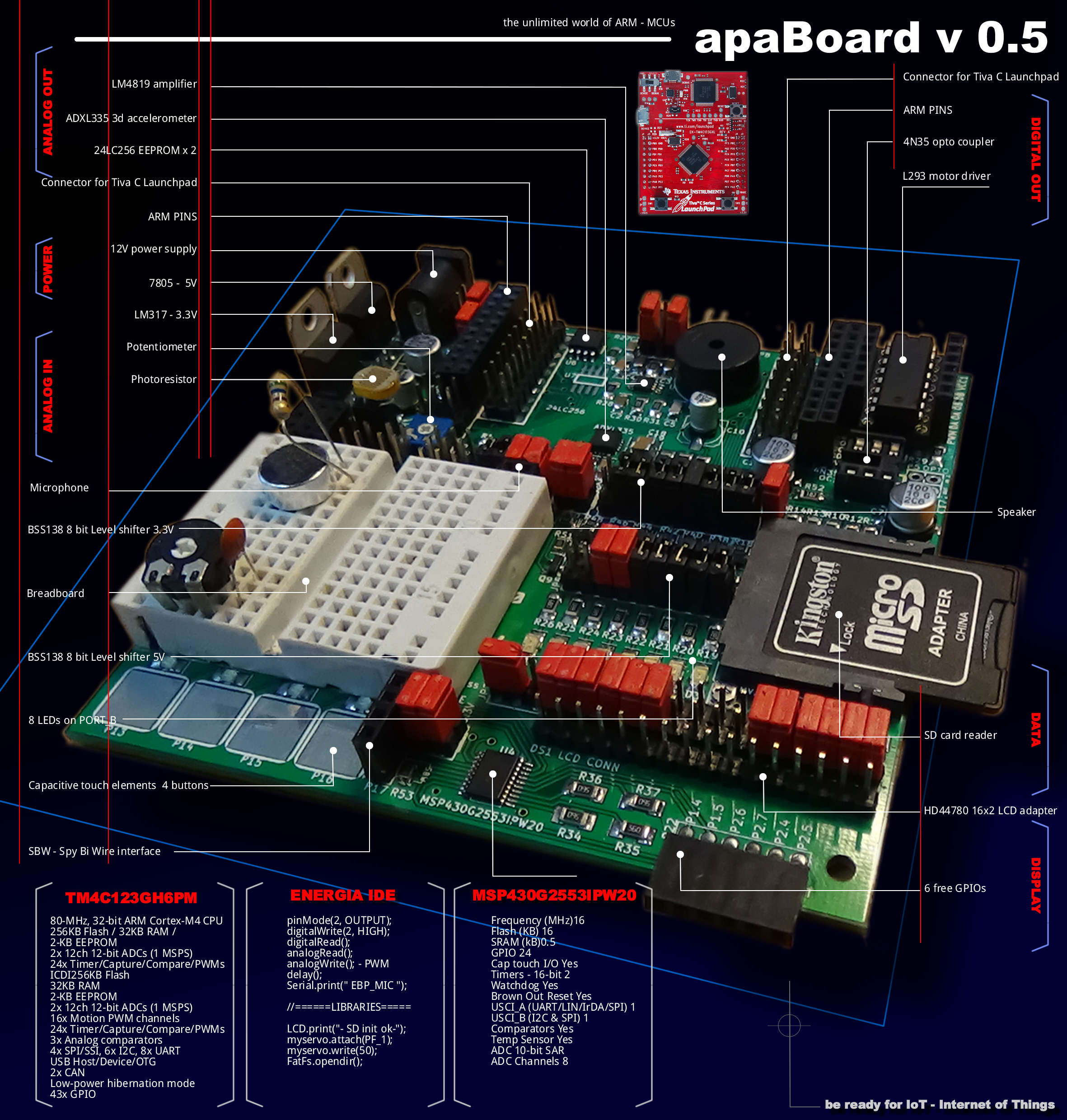 4. Another big challenge is that after the first steps, everybody would like to build, construct a physical device like robot with motors and arms. How can a teacher build a multipurpose, scalable device?. I've got the solution, this is the Deluxe box but it is heavy and a big and more complex to be reproduced. 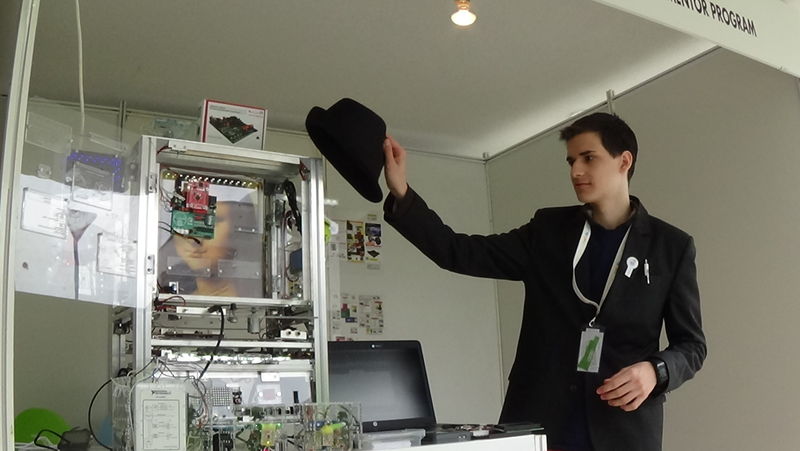 This gives me the idea to make some little deluxe boxes which I named MyBox. It can be made from a single sheet of plexiglass with laser. And it is an universal case for all type of experiments. Now we have a completely correct electrical experiment and we can build the multi purpose physical device too. 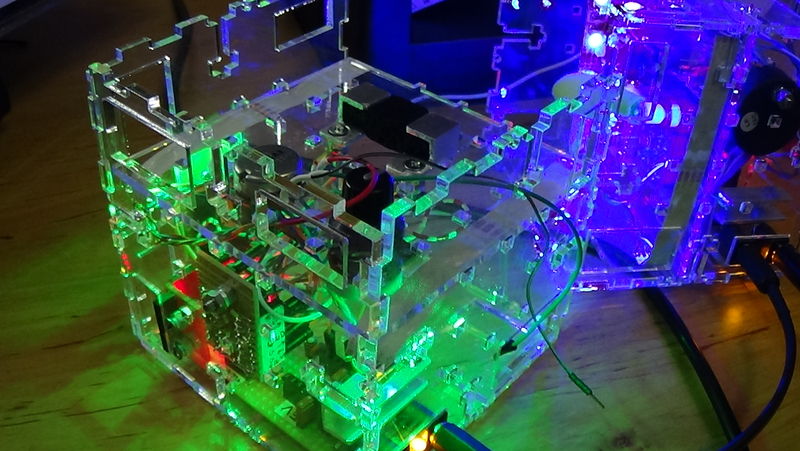 Softwares for programing MCUs: 1. The most of the IDEs use C, C++ language for programming registers. It is not a good solution for K12, is good for university's students or engineers. 2. But we have a lot of free IDEs for learning easly and working efficiently. Like Arduino IDE, and Energia IDE. These are using a simplefied C language, based on wiring, and they are good solution for K12's students. 3. Now we can do devices and we can program their MCU's, but if we can't visualise data, students can see only numbers. The LabVIEW is developed by engineers and uses a graphical programming language. Students can quickly understand, what happens in a circuit or in our tools. They can use a LabVIEW's Student Edition version, witch is free for 6 month. How do you think your implementation will improve teaching and learning (the pedagogical basis)? Teachers can adapt my learning and experimenting resources into their curriculum. For example if a teacher has a class about analog signals, or sensors, he can go to my website and he gets a completely built exciting experiment with all materials, like videos, source codes. With the apaBoard and MyBox and their online resources the preparation for a class is shorter. Each student has 1:1 device and the student can start the learning process from everywhere: for example somebody wants to build a sound recorder, or a heat sensor, or a moving car, even an eggbot. The learning process is based on building a good device and the student learns the electronics by constructing something. What is the biggest challenge you expect to encounter regarding implementation? The biggest challenge was that I have to spend a lot of time to learn a lot of softwares which I use everyday. Now I have a solid background which helps me in design, communication, resource management system. I use: Kicad, Keil/CCS, LabVIEW, MediaWiki content management system, SketchUp, LibbreOffice, FireWorks, Inkscape, LightWorks and now I'm interested in learning to use Moodle. |
Unit 3: Implementation
U3 Activity Break: If You Give a Student Technology
If You Give a Kid an apaBoard
| If You Give a Kid an apaBoard |
|
I’ve been developing, testing, using, teaching with my tool for about two years. I’ve tested in many situations, schools, classes, ed. tech. shows, science expos: Science on Stage, Agora, Mobilis, Milset 2015 and competitions like EUCYS 2014 This is how it works in classrooms, in hand of a student. They are excited:) |
ASSIGNMENT 3.1: ANALYZE BARRIERS & OPPORTUNITIES
Barriers & Opportunities of the apaBoard system
| Barriers & Opportunities of the apaBoard system |
| The most important problem isn’t the development and the technology but the attitude of teachers and the environment (Justin Reich, Jeff Mao). I am taking into consideration the gereral situation adopted to the specifical Hungarian state. My development can be used generally in learning electonics, informatics and physics.
Justin Reich: “They’re willing to spend hundreds of thousands of dollars on tools and orders of magnitude less money spent on people.” Jeff Mao: “They’re going to be talking about things like professional development and trying to be able to get enough support to think about how to incorporate the new technology of the day. |
| The most important barriers: - Teachers payment. Teachers are very oveloaded, they have a lot of extra work. They are underpaid, an average Hungarian teacher salary in 550 USD (490€) / month. Most of the teachers have private classes or private works. - Curriculum. Curriculum is Hungarian state-schools is strict regulated. Most of the teachers use behaviouristical, linear methods to teach. The introduction of new technologies are very centralized by state and implementation is very challenging. - Fundings. Aquisition is very centralised driven by state. Only a few of schools or districts may have own funds for paying for new implementations (FLL conferece Debrecen, 2014) Teachers workday is full with tasks so it is challenging for them to learn new technologies. While they are underpaied their motivation is challenging to be maintained. Most of them don’t want to diverge from curriculum. Solutions: 1. I offer a very strong educational support to my tool, apaBoard (like what Susan Russo says about Elements 4D. “The website comes with all different kinds of lesson plans”) 2. I must fully integrate into the existing curriculum so teachers wouldn’t have to make changes into curriculum. For example a teacher can download and use step-by-step fully developed lesson plans. 3. As funding is a great problem I have to introduce a freemium service. I am trying to gather funds to manufacture couple of hundred of apaboards and myboxes. Teachers who want to be involved into using my tool will have a short (3-4 wekks) Moodle course and will get a device and support for free test-year and usage before they would introduce in a school. After a year of testing I suppose that those who remains in the group would be able to use successfully. Summarising: I’ve been developing, testing, using, teaching with my tool for about two years. There are some similar developments mostly in USA which strengthen me that this way is not a bad one. Teachers don’t have to make long curves in their everyday work. They introduce the tool and their role are facilitator, to help the students build what they want. Here is a short video about how apaBoard works in real life. |
Unit 4: Evaluation
ASSIGNMENT 4.1: QUESTIONS FOR EVALUATION
Evaluating apaBoard in educational context
| Evaluating apaBoard in educational context | |||
|
1. Why am I evaluating?
There are many different reasons to evaluate a program. In both these situations I want to know: Evaluation for self-teaching students or groups Evaluation in schools I want to evaluate for several reasons: 2. Tell us about your vision of success for the implementation. I have 6 to 10 anchors to curriculum (like resistance, capacitance, inductance, data acquisition, data display, 3. Generate questions that will guide the evaluation. This questions quiz would be repeated after two month. General questions at start: These questions at end in a different but in a concrete manner: The communication of results are useful in future developments both for the device, the educational technology based resources videos, multimedia. Flyers for introduction of the apaBoard. |
|||
| FLYER for teachers | FLYER for students | ||
ASSIGNMENT 4.2: FINISH YOUR PROJECT
apaBoard finish – ready for implementation?
| apaBoard finish – ready for implementation? |
| Introduction: why do we need the apaBoard? We have to learn IoT! |
| Part 1: Target Environment/Implementation Context K9-12 in schools and at home 1:1.
My tool and method is for K12 (K9-to-K12) for students, educators, and communication staff of technology developers like Arduino, TI Launchpad, NI MyDAQ, MyRIO. It can be implemented in curriculum in learning process of electronics, informatics, physics. |
| By online tutorials students may go ahead by their own pace even without educator support. It is very suitable for blended learning. In this case students can do experiments in small or larger groups. The teachers role is facilitator in this case. Also they are involved in building and developing new methods bysuccessful experiments. A successful experiment will be inserted into the resource. Stakeholders: my online resources: 1. The videos explain the problem. Part 2: The Technology |
| a title="tool" href="http://eskolar.com/apa/index.php/MITx_11.133x_-_work#ASSIGNMENT_2.1:_YOUR_TOOL_FOR_SELECTING_EDUCATIONAL_TECHNOLOGY" target="_blank" rel="nofollow">2.1 My interactive online tool to analyse readiness
I have got a great inspiration from Stacey Allen’s Rubric to Determine Readiness for 1:1 Implementation. Thank You Stacey Allen. |
| Welcome to try it online from my webpage: http://eskolar.com/download/11_133/form/
You know I had talked with more then one hundred teachers, more than one thousand students, I know what they want, and what I want. In the next step I want that a school leader can use my selector tool to see whether the school is ready for implementation. You can try it online from my webpage
|
| 2.2 Choosing the right technology for apaBoard
More details: |
| Part 3: Implementation barriers & opportunities analysis
The most important problem isn’t the development and the technology but the attitude of teachers and the environment (Justin Reich, Jeff Mao). I am taking into consideration the general situation adopted to the specifical Hungarian state. My development can be used generally in learning electronics, informatics and physics. |
| The most important barriers: - Teachers payment - Curriculum. - Fundings. Teachers workday is full with tasks. Solutions: - I offer a very strong educational support to my tool, apaBoard (like what Susan Russo says about Elements 4D. “The website comes with all different kinds of lesson plans”) - I save time for preparing experiments Teachers don’t have to make long curves in their everyday work. They introduce the tool and their role are facilitator, to help the students build what they want. Here is a short video about how apaBoard works in real life. |
| Part 4: Evaluation
A STUDENT HOW EFFICIENT AND DEEP HAS LEARNED AN ELECTRICAL TOPIC in which he was interested? Evaluation for self-teaching students or groups Evaluation in schools I want to evaluate for several reasons: I’ll continu to develop these online tools for evaluation. |
Submit Your Project for the Live Event
I asked that my project to be part of the Live Event: Hangout on Air on Tuesday, August 25, 2015 11:00 PM UTC?
Teachers select a few final projects for critique.
I'am very happy and excited for the kind words.
